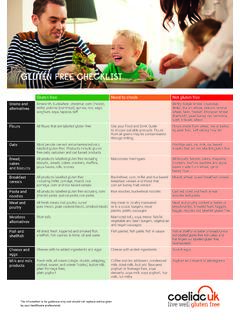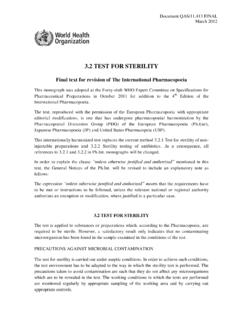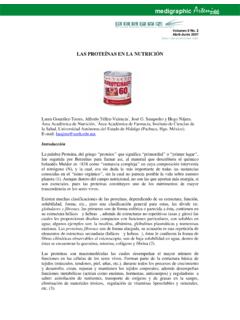Transcription of Technical Bulletin #3 Sugar bean production in Zimbabwe
1 Plough land to a depth of 20-25cm to bury previous crop residues and weeds. Technical Bulletin #3 Sugar bean production in Zimbabwe 1. Introduction Sugar beans (Phaseolus vulgaris) is a grain legume grown in Zimbabwe by smallholder and large scale farmers. Sugar bean has potential as a rain-fed and irrigated crop with potential returns of $5 - $10 per unit of family labor depending on conditions. The Zim-AIED program will continue the work on Sugar beans started by several USAID grantees under cooperative agreements but with greater emphasis on provision of Technical services by private sector partners. 2. Climate and soil requirement Sugar bean is sensitive to frost. Well drained sandy loams to clay loam soils pH to are suitable. The crop is adversely affected by acidic soils and poorly drained soils.
2 Excessive rain creates conditions conducive for the development of fungal diseases and causes flower drop leading to reduced yields. 3. Land preparation Plough land to a depth of 20-25cm to bury previous crop residues and weed seeds. Early correct land preparation enhances moisture retention and is useful for weed and disease control. Soil preparation should produce a level and fine tilth to ensure ideal seed-soil contact and to minimize soil crusting. 4. Planting Seed rate should be 75 to 120 kilogram per hectare. Use disease free high quality seed with a high germination percentage. Low quality seed leads to an uneven crop stand and low yields. Locally available varieties are PAN 138, PAN 127, Purple Cardinal, Bonus, Natal Sugar , Gloria and Nua 45. Zim-AIED Technical Bulletin | Sugar bean A frost damaged bean crop.
3 Variety choices determined by market preferences, growth habit, disease tolerance, season length as well as soil and climatic conditions. Seed dress with Thiram 80WP at a rate of 35 grams per 50 kilograms seed or Apron Star to control damping off. Planting depth to 5 centimeters depending on soil texture and moisture content levels. Very shallow planting increases the risk of the seed being exposed to the sun and drying out before germination as well as seedling drying out after germination, while planting too deep weakens seedlings as well as increases the risk of soil-borne diseases. Spacing; 40 to 60 centimeter interrow, 5 to 8 centimeters within the row. 170,000 to 320,000 plants per hectare depending on whether bean variety is determinate or indeterminate as well as plant size.
4 It is critical to target optimum plant populations as this has a bearing on disease incidence and weed control. Very high plant populations create ideal conditions for disease spread while low plant populations encourage weed infestation and produce low yields per unit area. Crusting soils restrict seedling emergence resulting in poor crop stand and thus require a higher seeding rate. For optimum crop quality, avoid frost and high temperatures which affects flowering (blossom drop) and pod setting during planting time. In lowveld areas plant at the end of summer, while in the highveld avoid winter planting or planting after the first week of March in frost prone areas. Lowveld irrigated crop plantings are recommended from December to end of April Planting material The quality of seed determines the yield levels and quality of crop produced.
5 Farm retained seed, especially over several seasons, leads to reduced vigor and lower yields as well as serious seed borne disease problems. It is recommended that certified disease free seed be used and recycling of seed be discontinued after two to three seasons. Positive selection should be used where farm seed is to be retained - select seed only from highly productive and disease free plants. 5. Growing season Eighty-five to 104 days - Shorter length of season for determinate varieties and longer season length for indeterminate varieties. Summer bean crops planted earlier than mid-December may be affected by foliar diseases, pod rots and poor germination resulting in yield losses. Dry land summer crops should be planted from mid-December to the end of January to avoid crop maturity in the middle of the rainy season.
6 | | | Technical Bulletin #3 | February 2014 Zim-AIED Technical Bulletin | Sugar bean In general, highveld summer crops should not be planted after the first week of March to avoid frost damage that affects later plantings. The later plantings (after end of January) in the recommended planting window are only possible where supplementary irrigation is available. Lowveld winter crops should be planted in the period from late December to end of April. Later Lowveld plantings may be prone to frost damage, rust and serious aphid infestations 6. Rotations Benefits of practicing crop rotations. Crop rotations help to control pests and diseases and improve soil fertility. Soil fertility is built up through the inclusion of legumes, such as Sugar bean , groundnuts, soya beans, cowpea and pigeon pea, which add fertility to the soil.
7 Sugar bean should not be planted in the same field in consecutive years to minimize disease and pest incidence. The crop should be rotated with cereals such as maize. Sugar beans can be susceptible to residual herbicides such as Atrazine. It is therefore critical to establish the history of the rotated lands in as far as herbicide use is concerned. 7. Fertilization Ideally, use soil tests. Use a basal fertilizer that is high in phosphorous content. Generally basal fertilizer: 300 to 400 kilograms per hectare Compound D (7:14:7) NPK. Top dressing: 100 kilograms of Ammonium Nitrate per hectare not less than 21days after planting. Avoid excessive nitrogen as it promotes vegetative growth at the expense of pod formation resulting in lowered yields. Zinc supplement through foliar fertilizers can be useful where there is a deficiency.
8 8. Macro-nutrient deficiencies Nitrogen Deficiency Symptoms: Young leaves are lighter green than normal (yellowish green), lower leaves becoming light green developing to a yellow color and eventually die. Potassium Deficiency Symptoms: Bright yellowing of older leaves which appears first from the margins and extending rapidly to the center of the leaflet (inter-veinal chlorosis). Phosphorus Phosphorus deficiency is the most common disorder of beans. Phosphorus is very important for root development as well as optimum flower and seed formation. It is thus an important yield limiting factor. Deficiency Symptoms: Phosphorus deficiency appears as small, dark-green leaves. Older leaves may die and fall earlier than normal. Plants have short internodes and reduced branching. Zinc Deficiency symptoms: Inter-veinal yellowing and chlorotic spotting which progresses to leaf bronzing.
9 Leaflets are elongated and leaf margins may be wavy. Poor pod formation. 9. Irrigation Sugar beans are not tolerant to water logging and therefore irrigation should be managed to avoid waterlogging especially when using flood irrigation. | | | Technical Bulletin #3 | February 2014 Zim-AIED Technical Bulletin | Sugar bean Water stress during the flowering and pod filling periods can reduce yields and therefore irrigation schedules should be managed to avoid water stress during these periods. It is desirable to attain soil moisture content at or near field capacity at planting. During the flowering and pod development period, soil moisture levels in the root zone should not be depleted to less than 50 percent of field capacity to achieve maximum yields. The water holding capacity of soil and its depth has great influence over determining frequency of irrigations and water volumes to be applied per irrigation cycle.
10 In general the greater the water holding capacity of the soil the less frequent the irrigations should be. Irrigations may need to be scheduled in ways that help minimize disease problems. When using overhead irrigation, irrigate at night or early in the morning, if possible, and let foliage dry during the day to reduce disease problems. To minimize aiding the development of white mold, do not use light, frequent irrigations except during germination. Late season irrigation can delay maturity and therefore irrigations can be discontinued when about 50 percent of the leaves on the bean plant are yellowing or when at least 80 percent of the pods have become yellow. Proper irrigation scheduling is important (consult extension staff for assistance) | | | Technical Bulletin #3 | February 2014 Zim-AIED Technical Bulletin | Sugar bean 10.







